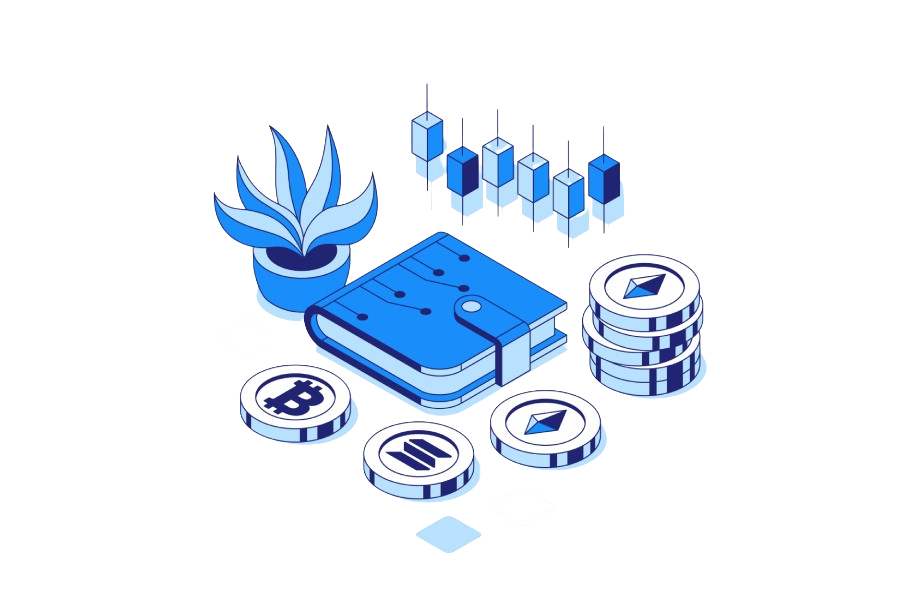What Are NFTs and Why Are They So Popular?
Non-fungible tokens, or NFTs, are a type of digital asset that represent a unique item, such as a piece of art, music, or even a tweet. The term “non-fungible” refers to the fact that each NFT is one-of-a-kind and cannot be replaced by something else of equal value.
What Are NFTs and Why Are They So Popular?
Table of Contents
Key Takeaways
- NFTs were created on the Ethereum blockchain in 2017 and have recently exploded in popularity with high-profile auctions selling for millions of dollars.
- NFTs are unique because each token has its own value based on demand from buyers and is recorded on the blockchain with a unique digital signature.
- Popular types of NFTs include art, gaming, music, and sports assets. Other categories include virtual real estate and tweets.
- There are legal and ethical considerations when creating and trading NFTs such as copyright issues, environmental concerns, and social impact opportunities.
- The future of NFTs offers many possibilities across various industries while facing challenges such as fraud risk, hype bubbles, and energy consumption.
Introduction
In recent years, a new type of digital asset has taken the world by storm: the non-fungible token, or NFT for short. At its core, an NFT is a type of cryptocurrency that represents a unique digital item, such as a piece of art, music, or even a tweet.
While NFTs have been around since 2017, they have recently exploded in popularity, with some NFTs selling for millions of dollars at auction. So what is driving this newfound interest in NFTs, and why are they so valuable?
To answer these questions, we first need to understand the history of NFTs.
A brief history of NFTs
The first NFTs were created on the Ethereum blockchain, a decentralized platform for building smart contracts and decentralized applications. The idea was to create a digital asset that was truly one-of-a-kind, with a unique digital signature that could be verified on the blockchain.
Despite their potential, NFTs remained relatively obscure until 2021, when a series of high-profile NFT sales made headlines around the world. From Jack Dorsey’s first tweet selling for $2.9 million to a digital artwork by Beeple selling for a record-breaking $69 million, NFTs have captured the attention of collectors, investors, and artists alike.
Misconceptions
With this newfound attention comes a number of misconceptions about what NFTs are and how they work. Some people assume that NFTs are simply a new form of digital currency, while others worry that they are contributing to the environmental problems associated with blockchain technology.
In the following sections, we’ll explore the world of NFTs in more detail, separating fact from fiction and exploring the potential and pitfalls of this exciting new digital asset class.
What is an NFT and How Do They Work?
Non-fungible tokens, or NFTs, are a type of digital asset that represents a unique item, such as a piece of art, music, or even a tweet. The term “non-fungible” refers to the fact that each NFT is one-of-a-kind and cannot be replaced by something else of equal value.
Creating NFTs
NFTs are created using blockchain technology, which is a decentralized, distributed ledger that records transactions across a network of computers. Each NFT is stored as a unique digital token on the blockchain, along with a digital signature that verifies its authenticity and ownership.
To create an NFT, an artist or creator typically creates a digital file of their artwork or another unique item, such as a video clip or a tweet. They then upload this file to an NFT marketplace or platform, where it is minted into an NFT using blockchain technology.
Once an NFT is created, it can be bought, sold, and traded just like any other digital asset. However, unlike other cryptocurrencies like Bitcoin or Ethereum, each NFT is unique and has its own value based on the demand from buyers.
Comparing NFTs to Physical Assets
One way to think of NFTs is to compare them to physical assets like paintings or sculptures. While anyone can make a copy of a painting or a sculpture, there is only one original, and that original has value because of its uniqueness and the fact that it was created by a specific artist.
Similarly, an NFT represents a unique digital item that cannot be replicated, even though the underlying digital file may be widely available. The value of an NFT comes from the fact that it is one-of-a-kind and has a verifiable digital signature that proves its authenticity and ownership.
Comparing NFTs to Other Cryptocurrencies
While NFTs are similar to other cryptocurrencies in that they are based on blockchain technology, they are different in a few key ways. Unlike Bitcoin or Ethereum, which are designed to be fungible, meaning that each coin is interchangeable with another coin of equal value, NFTs are non-fungible and represent a unique item.
How are NFTs Used?
While cryptocurrencies like Bitcoin and Ethereum are primarily used as a medium of exchange, NFTs are used more for collectibles and digital assets. They are often used in the art world as a way for artists to monetize their digital creations and sell them to collectors.
NFTs represent an exciting new frontier in the world of digital assets, offering a unique way to own and collect digital items that were previously considered intangible. While there are still many questions and concerns around NFTs, their potential for creating new opportunities for artists, collectors, and investors is undeniable.

Types of NFTs and Their Significance
While NFTs can represent almost any type of digital asset, there are a few categories that have emerged as particularly popular among collectors and investors. Here’s a brief overview of some of the most common types of NFTs, along with examples of popular NFTs in each category:
Art NFTs
Perhaps the most well-known type of NFTs are those that represent digital art. These NFTs allow artists to monetize their work in a way that was previously impossible, giving them a new way to earn income and reach new audiences.
Examples of popular art NFTs include Beeple’s “Everydays: The First 5000 Days,” which sold for $69 million at auction, as well as works by artists like Trevor Jones, Pak, and Krista Kim.
Gaming NFTs
NFTs are also becoming increasingly popular in the world of gaming, where they can be used to represent unique in-game items, such as weapons, armor, or even entire virtual worlds.
One popular example of gaming NFTs is Axie Infinity, a blockchain-based game that allows players to collect and battle creatures known as “Axies.” Each Axie is represented by an NFT, which gives it a unique set of attributes and abilities.
Music NFTs
Musicians and music producers are also starting to experiment with NFTs, using them to represent unique digital albums, songs, or even concert tickets.
One of the most high-profile examples of music NFTs is Kings of Leon’s recent album release, which was made available as an NFT bundle that included exclusive artwork, backstage passes, and other perks.
Sports NFTs
NFTs are also making waves in the world of sports, where they can be used to represent unique digital memorabilia, such as trading cards, jerseys, and other items.
One popular example of sports NFTs is NBA Top Shot, a platform that allows users to buy and sell digital trading cards that feature highlights from NBA games. Some of these NFTs have sold for hundreds of thousands of dollars, making them some of the most valuable digital assets in the world.
Other Types of NFTs
Of course, these are just a few examples of the many types of NFTs that are currently available. Other popular categories include virtual real estate, collectibles, and even tweets.
NFTs offer an exciting new way for creators, collectors, and investors to interact with digital assets. By giving each item a unique digital signature and a verifiable history on the blockchain, NFTs allow us to create, own, and trade digital items in a way that was previously impossible. As the world of NFTs continues to evolve, we can expect to see even more creative and innovative uses for this exciting new technology.
Legal and Ethical Considerations for NFTs
While NFTs offer a lot of exciting possibilities, there are also a number of legal and ethical concerns that need to be addressed. Here are a few of the most important issues to keep in mind:
Copyright and Ownership Issues
One of the most pressing issues around NFTs is the question of copyright and ownership. When an artist creates an NFT, they are essentially creating a new type of asset that represents their original work. However, this can raise questions around who owns the underlying intellectual property and whether the artist has the right to sell the work as an NFT.
To address these issues, some NFT marketplaces and platforms have begun to implement measures to verify the ownership and authenticity of the digital assets being sold. Additionally, some artists are using NFTs to establish more transparent and equitable systems for compensating creators and ensuring that they receive fair compensation for their work.
Environmental Concerns
Another issue that has been raised around NFTs is their impact on the environment. Because NFTs are created and traded on blockchain networks, they require a significant amount of energy to process and verify each transaction. This has led to concerns that NFTs could contribute to the environmental problems associated with cryptocurrency mining and other blockchain-based activities.
To address these concerns, some NFT marketplaces and platforms are exploring more sustainable ways of creating and selling NFTs, such as using alternative blockchain networks that require less energy. Additionally, some artists and collectors are using NFTs as a way to raise awareness and funds for environmental causes.
Social Impact and Charitable Causes
Despite the legal and environmental concerns surrounding NFTs, there is also potential for NFTs to be used for social impact and charitable causes. For example, some artists are using NFTs as a way to fundraise for social justice causes, such as racial justice or climate change. Additionally, some NFT marketplaces are donating a portion of their profits to charitable causes, such as art education programs or disaster relief efforts.
While NFTs offer a lot of exciting possibilities, it’s important to approach them with a critical eye and consider the legal, ethical, and environmental implications of creating, buying, and selling these unique digital assets. As the world of NFTs continues to evolve, we can expect to see more innovative uses of this technology that balance the potential benefits with the need to address these important issues.
The Future of NFTs: Trends, Challenges, and Opportunities
As the world of NFTs continues to evolve, it’s clear that this exciting new technology has the potential to make a major impact on the digital world. Here’s a look at some of the ways that NFTs could be used in the future, as well as some of the challenges that may lie ahead.
NFTs in Various Industries
One of the most exciting things about NFTs is their potential to be used in a wide range of industries. For example, NFTs could be used in the fashion industry to represent unique digital clothing designs or in the film industry to represent rare and valuable film memorabilia.
In the gaming industry, NFTs are already being used to represent unique in-game items and virtual real estate, and this trend is likely to continue as more and more games adopt blockchain-based technology. Additionally, NFTs could be used in the music industry to represent unique concert tickets or special VIP experiences.
Challenges Facing NFTs
Of course, there are also a number of challenges that NFTs may face in the future. One major concern is the potential for fraud and scams, as some unscrupulous individuals may try to create fake NFTs or exploit vulnerabilities in the technology.
As the market for NFTs continues to grow, there is a risk that the hype around these digital assets could create a bubble that eventually bursts, leaving some investors with significant losses.
Finally, there are also environmental concerns around the energy consumption of blockchain-based technologies, which could limit the scalability and sustainability of NFTs in the long run.
Future Trends in the NFT Market
Despite these challenges, it’s clear that the market for NFTs is only going to continue to grow in the coming years. As more and more creators, artists, and collectors embrace this new technology, we can expect to see new and innovative uses for NFTs emerge.
One trend that is likely to continue is the use of NFTs as a way for creators to monetize their work and reach new audiences. Additionally, we may see more NFT marketplaces and platforms emerge, each with its own unique features and offerings.
The future of NFTs promises to be exciting and full of potential. While there are certainly challenges to be faced, the unique properties of NFTs offer a new way to create, own, and trade digital assets that has never been possible before. As the world of NFTs continues to evolve, we can expect to see new and innovative uses of this exciting technology that we can’t even imagine yet.
Final Thoughts
While there are certainly challenges and concerns to be addressed, it’s clear that NFTs offer a new way to think about digital ownership and value. With the ability to create unique, one-of-a-kind digital assets that are verifiable on the blockchain, NFTs are creating new opportunities for artists, collectors, and investors alike.
As we look to the future of NFTs, there are many exciting possibilities on the horizon. From new types of NFTs to new industries that could benefit from this technology, the potential for NFTs to transform the digital world is immense.
Whether you’re an artist looking to monetize your work, a collector looking for a new way to invest, or just someone who is curious about the future of digital ownership, NFTs offer a world of possibilities to explore.
We hope you enjoyed this Coinmama Academy article! If you have any questions, drop us a line at support@coinmama.com, and don’t forget to follow us on Facebook, Instagram, and Twitter. If you’re ready to start building your own cryptocurrency portfolio, just head to our main website or pick up our free self-custody crypto wallet that lets you store your crypto safely and buy Bitcoin directly in the app!
Table of Contents
Related articles

What is Bitcoin Adoption?

What is a Bitcoin Loan?







